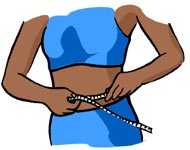 There
is a huge amount of sometimes conflicting, often confusing, nutrition and
diet information available. Therefore, it’s very understandable when people
become discouraged about selecting an eating plan for themselves. Even
scientific studies often contradict each other. How can we figure out how
best to eat for overall health or weight loss?
There
is a huge amount of sometimes conflicting, often confusing, nutrition and
diet information available. Therefore, it’s very understandable when people
become discouraged about selecting an eating plan for themselves. Even
scientific studies often contradict each other. How can we figure out how
best to eat for overall health or weight loss?
We can focus on the basics. Unless you’re going to follow
a strict diet that restricts or eliminates certain food groups (which should
be carefully studied prior to starting), you can begin by striving for
balance in your diet. Below are some common-sense guidelines that you can
use to identify what kind of an eating plan works best for your lifestyle
and your body.
1. Start drinking more water. Most experts recommend eight
(8-ounce) glasses per day. The easiest way to do this is to spread out
your water intake throughout the day and use containers that will help
you keep track how much you drink. If you aren’t drinking much water currently,
try easing into it. You can add one cup every few days until you reach
8 or more per day.
2. Strive to eat 1-2 servings of fruits or vegetables
at each meal or snack. This will add up to several servings a day which
is recommended for optimal nutrition.
3. Switch to whole grains. Go for the healthier whole
grains in breads, pasta, tortillas, and cereals. Also eat brown rice instead
of white. You’ll be taking in more beneficial fiber and gaining all the
other benefits of whole, rather than processed, grains.
4. Get your sweet tooth under control. Start to slowly
reduce the portion sizes and frequency of your intake of any sugared treats.
Try switching to unsweetened breakfast cereals. Go from full-sized candy
bars to bite-size. And, if you are accustomed to eating dessert after every
meal, switch to fruit as a dessert a few times per week. The less you eat
the sweets, the less you’ll crave over time (really!).
5. Switch to lean meats. Avoid highly marbled beef, high
fat pork ribs and chops, regular ground beef and other fatty cuts. Try
substituting lean ground beef and turkey, pork tenderloin and flank steak,
along with fish and shellfish.
6. Switch to lower fat dairy products. You can really
influence your calorie and fat daily totals by switching to lower fat milk,
cottage cheese, cheese, sour cream and more. If you enjoy fat-free, work
your way down to that. If you really don’t enjoy the taste, then go to
the lower fat varieties (that’s what I do!).
7. Find a couple of lower fat salad dressings that you
enjoy. With all the vegetable you’ll be eating as part of your new eating
style, a couple healthier dressing options will go a long way toward making
them more enjoyable. In addition to using on salads, you can use dressings
for marinade, dips, sandwich spreads, and whenever you can use some extra
flavor.
8. Slowly reduce your portion sizes. Most people who are
carrying around some extra weight probably are eating too much food. By
slowly reducing your portion sizes, you’ll feel less deprived as you make
your way down to a portion size you feel comfortable and satisfied eating.
9. Learn how to read and compare nutrition label information.
This will help avoid common mistakes made by people experimenting with
healthier foods, such as overeating low fat items even though they contain
as many calories as the full-fat varieties. Look at things like fiber,
protein and sugar content to help you understand what you’re feeding your
body and how it makes you feel.
10. Although this isn’t directly an eating issue, increase
your activity! Healthy eating is only half of the equation. For ideal health,
your body needs to move and move often. Again, start slowly and gradually
increase your activity. This doesn’t necessarily mean hard exercise walking,
housework, gardening and running around with your kids can lead to healthy
changes in your fitness level. Many experts recommend 30 minutes of exercise
three times a week as a minimum for overall health. Each person should
talk with their doctor, and determine what type and level of exercise will
best suit them.
Even though you may determine you want to make additional
lifestyle changes, these basic healthy tips will give you a great start
toward improved health. Take it at your own pace and make changes that
fit into your lifestyle. You don’t need to eat foods you don’t enjoy just
because they are healthy. It would be better for you to experiment to find
foods you do enjoy, so that you are motivated to keep eating them. Always
keep in mind that you’re making these changes to become a healthier person
that will live a longer, more active life!
Erin Rogers, a work-at-home mom of two, is the founder
of Health-E-Meals.com, providing practical healthy living resources for
busy people and author of Healthy
Express Cookbook: 101 Fresh, Light & Quick Dinners. Visit her website
to sign up for the FREE newsletter, 'Dinners on the Double' - offering
a quick and healthy, no-recipe dinner idea each week. Other available services
include quick and healthy recipes, healthy cooking articles, fitness and
motivation tips, healthy living web links, and lots more! Erin can be reached
via email here.



 There
is a huge amount of sometimes conflicting, often confusing, nutrition and
diet information available. Therefore, it’s very understandable when people
become discouraged about selecting an eating plan for themselves. Even
scientific studies often contradict each other. How can we figure out how
best to eat for overall health or weight loss?
There
is a huge amount of sometimes conflicting, often confusing, nutrition and
diet information available. Therefore, it’s very understandable when people
become discouraged about selecting an eating plan for themselves. Even
scientific studies often contradict each other. How can we figure out how
best to eat for overall health or weight loss?